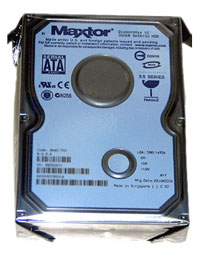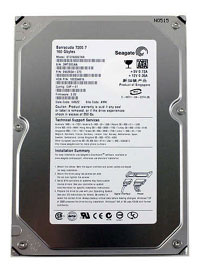Buyer's Guide - Mid-Range, January 2005
by Jarred Walton on January 21, 2005 11:09 AM EST- Posted in
- Guides
Hard Drive Recommendations
We have already said a lot on the topic of hard drives in our past Guides, and there really isn't a whole lot to add at this point in time. Higher capacity models are on the way in the not too distant future, but they will carry with them higher price tags. We recommend SATA drives for most people these days; vendors price them similarly to IDE and it is easier to route the cables. If you're into extreme overclocking, however, IDE may be worth considering. Performance isn't all that different - barring the lack of certain high-end options - and many systems have difficulty reaching top overclocked speeds with SATA drives. For nForce3 250 chipsets, we have found that SATA ports 1 and 2 are more likely to have problems than ports 3 and 4. So, unless you want more than two SATA hard drives, you should be fine.
Hard Drive Recommendation
Seagate 160GB SATA with NCQPrice: $105 Shipped
The best value in terms of price per GB of storage currently goes to the 250 GB Hitachi drive [RTPE: HDS722525VLAT80], at just under 55 cents per GB. 250 GB is a lot of storage, however - probably more than most people really need. With the added benefit of Native Command Queuing (NCQ), the Seagate drives continue to impress. The Seagate 160 GB SATA [RTPE: ST3160023AS] offers the best value of the bunch, at roughly 70 cents per GB, but you also get a longer 5 year warranty. Samsung is a slightly better bargain, so if you don't think NCQ is worth paying extra, you can pick up the 160 GB Samsung for $15 less. We give the recommendation to the Seagate drives, although all of the others that we listed are reasonable alternatives.
 |
 |
| Click images to enlarge. | |
Hard Drive Alternatives
Maxtor 300GB SATA with NCQ and 16MB cachePrice: $194 Shipped
Western Digital Raptor 74GB SATA with TCQ and 10,000 RPM
Price: $177 Shipped
On the other hand, if improved performance is what you're after, the best two choices are either one of the 16MB cache Maxtor drives or the 74GB Western Digital Raptor [RTPE: WD740GD] with its 10,000 RPM design - the Maxtor also offers NCQ while Raptors "only" offer TCQ, in case you were wondering. For storage space as well as performance, we would go with a Maxtor drive, as they are available in 250 and 300 GB models. If you're going to get a drive that large, we would go with the 300 GB model [RTPE: 6B300S0] for the small price increase - 65 cents per MB is pretty good, especially considering the larger cache. If raw speed is your primary concern, the faster rotational speed of the Raptor still wins out, but it is one of the few non-SCSI drives to actually cost more than $1 per GB. Again, we recommend the larger version for its improved performance and features over the original Raptor, but at $177, it costs $2.40 per GB. These drives are great choices, and only you can decide whether raw speed or increased storage is more important, so we recommend them both.
You could even go with a RAID 0 configuration for a possibly small increase in performance, or if you're concerned about data loss, there's the possibility of RAID 1. For a truly high-end setup, you might even think about getting three or more drives and a separate SATA controller with hardware support for RAID 5. That combines the best of both worlds, but it's more than what anyone actually needs. If you're looking into RAID 5 options, make sure that you pick up a controller card with a hardware XOR engine to calculate the parity checks, or else performance will be greatly reduced. RAID of any form is generally a high-end option, however.











46 Comments
View All Comments
JarredWalton - Friday, January 21, 2005 - link
Rand - That doesn't surprise me too much, given our recent article showing that the NF4 Ultra and NF4 SLI are the same chip with a tweaked package. I would guess there's a reasonable chance the NF4 4X is the same as well, with other modifications to the package. As far as I know, what I put about their difference is the "official" NVIDIA stance. If the 4X is just the "validated" version... well, not a big deal, really. I'll modify the text a bit to reflect this.KristopherKubicki - Friday, January 21, 2005 - link
N3cr0: The nForce4 board you mentioned is not shipping yet.Kristopher
Jep4444 - Friday, January 21, 2005 - link
I think the Asus A8V Deluxe would of been a better motherboard recomendation than the MSI K8N Neo2 Platinum. The Asus board is pretty much the best 939 AGP board out and it costs less than the MSI aswell.Avalon - Friday, January 21, 2005 - link
'Samsung calls the 997DF a "perfectly visually flat" tube. What they really mean is that the surface of the glass is perfectly flat, but the inside of the glass is very slightly curved. Most people will never notice it, but we feel that in the interest of full disclosure, it should be mentioned'Yes. Thank you for pointing that out, Jared. I purchased this monitor about a month ago, and noticed it right upon powering it up. No matter how much you adjust the geometry, there is always a slight curve. I was so angry at one point I was either going to hit it with a bat or return it. Now I've just learned to deal with it, and I'm no longer really bothered by it.
Rand - Friday, January 21, 2005 - link
Slight addendum to my above post-I just tried nVidia's hardware firewall.. it's working fine.Apparently that also runs on the basic nForce4.
Rand - Friday, January 21, 2005 - link
Slight addendum to my above post-I just tried nVidia's hardware firewall.. it's working fine.Apparently that also runs on the basic nForce4.
Rand - Friday, January 21, 2005 - link
"The difference, if you recall, is that the Ultra has an unlocked HyperTransport multiplier and will generally offer more in the way of overclocking, while the 4X is locked at a 4X HyperTransport multiplier (800 MHz)."I believe that's since been proven false.
There are a couple threads in the Motherboards forum about overclocking on said board, and I haven't seen anyone comment on any difficulties adjusting the HTT.
My own board is running at 300x3 HTT (900MHz HTT) right now. (Adjustable from 2-5X), though it did need +0.2V to the chipset to run stable at 1000HTT.
The differences right now between the NF4 and NF4 Ultra would appear to be 3Gb/s SATA vs. 1.5Gb/s SATA, and official support for 1000HTT vs 800HTT.
As well as not supporting nVidia's firewall.
geogecko - Friday, January 21, 2005 - link
Where are all the nForce4 Ultra (non-SLI) boards? Really looking forward to ASUS A8N-E Premium, but no news, except that some have said this board will never exist?!Gage8 - Friday, January 21, 2005 - link
I don't know, this guide just confirmed for me that now is not the time to buy if you want stability and upgradability (new word?).Nforce2 taught me not to buy revision 1.x...so lesson learned, bring on Nforce4 revision 2.x.
N3cr0 - Friday, January 21, 2005 - link
Just curious why the MSI K8N Neo4 Platinum/SLI wasn't put in as an SLI board for the AMD choices. It seems to be lower price then the Asus board. I'm going to get one of the two boards and can't really figure out what the differences are aside from some networking items. (That and the HyperTransport which I dont get at all)